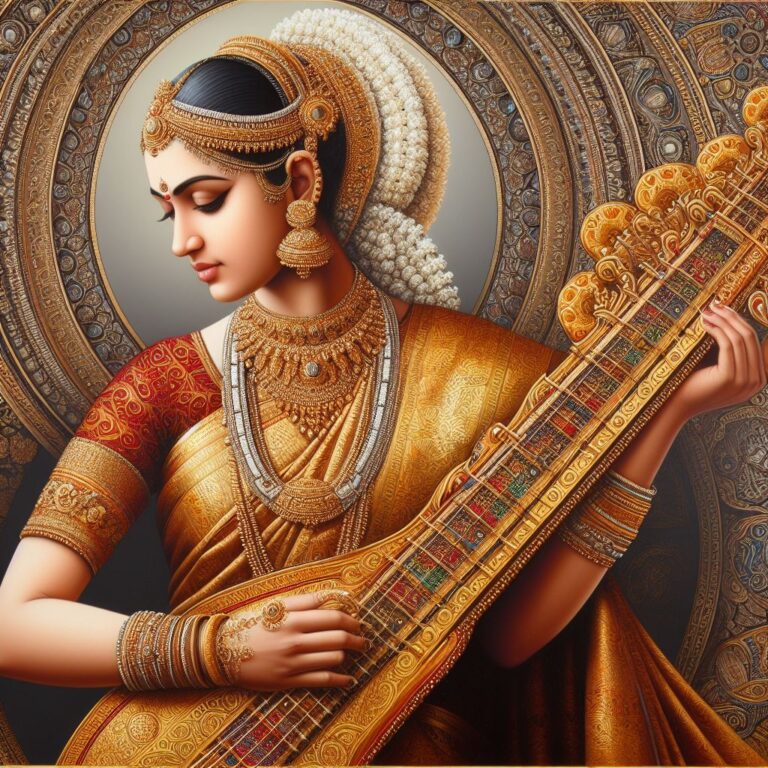Thanjavur painting, also known as Tanjore painting, is a classical South Indian art form that originated in the town of Thanjavur (Tanjore) in Tamil Nadu.
Renowned for its vibrant colors, intricate gold leaf work, and religious themes, Thanjavur painting is a cherished cultural heritage that has stood the test of time.
In this article, we delve into the captivating world of Thanjavur painting, exploring its history, techniques, distinctive features, and how aspiring artists can learn and master this exquisite art form.
Table of Contents
Historical Origins
Thanjavur painting has a rich historical lineage that dates back to the Maratha period in the 16th century.
It flourished under the patronage of the Maratha rulers and the Nayakas of Thanjavur, becoming an integral part of temple art and religious expression.
Initially, these paintings adorned the walls of temples and palaces, depicting deities, religious themes, and mythological stories.
Over time, Thanjavur paintings evolved into standalone art pieces, with artists incorporating intricate details and elaborate ornamentation.
Distinctive Features
Thanjavur paintings are characterized by their unique features, making them easily distinguishable:
- Rich Colors: Thanjavur paintings are known for their bold and vivid color palette, including bright reds, blues, greens, and yellows. The colors are derived from natural pigments, lending the artworks a timeless appeal.
- Gold Leaf Work: One of the hallmarks of Thanjavur painting is the lavish use of gold leaf and foil. Artists meticulously apply gold leaf to specific areas, enhancing the paintings’ opulence and grandeur.
- Intricate Detailing: Thanjavur paintings are renowned for their intricate detailing, including ornate jewelry, expressive facial features, and elaborate backgrounds. Artists pay close attention to every minute element, showcasing their mastery of the craft.
- Themes and Subjects: Thanjavur paintings predominantly feature religious themes, showcasing deities like Lord Krishna, Goddess Lakshmi, and Lord Ganesha. Mythological narratives and scenes from epics like Ramayana and Mahabharata are also popular subjects.
Learning Thanjavur Painting
Learning Thanjavur painting requires dedication, patience, and a deep understanding of the techniques involved. Here are steps to help aspiring artists embark on their journey to master this art form:
- Find a Skilled Guru: Enroll in classes or find a knowledgeable Thanjavur painting artist who can guide you through the fundamental techniques and intricacies of the art form. Learning directly from a skilled guru is invaluable.
- Master the Basics: Familiarize yourself with the tools, materials, and basic techniques used in Thanjavur painting. Practice sketching and outlining to develop your control and precision.
- Understand Color Theory: Learn about the traditional color palette used in Thanjavur paintings. Experiment with mixing colors and understand the significance of each hue in creating harmonious compositions.
- Practice Gold Leaf Work: Mastering the art of applying gold leaf is a crucial aspect of Thanjavur painting. Practice working with gold foil under the guidance of your guru to achieve the desired effect.
- Study Traditional Themes: Immerse yourself in the study of traditional Thanjavur painting themes. Understand the symbolism and stories behind each subject, allowing you to infuse depth and meaning into your artworks.
- Patience and Perseverance: Thanjavur painting is a meticulous and time-consuming art form. Cultivate patience and perseverance, allowing yourself the time to practice and refine your skills.
- Attend Workshops and Exhibitions: Participate in workshops conducted by experienced artists and visit exhibitions to gain exposure to different styles and techniques. Interacting with the art community can provide valuable insights and inspiration.
Thanjavur painting stands as a testament to the artistic brilliance and cultural heritage of Tamil Nadu.
Learning this traditional art form not only allows artists to express their creativity but also helps preserve a legacy that has transcended generations.
With dedication, guidance, and a passion for the craft, aspiring artists can embark on a fulfilling journey to master the art of Thanjavur painting, creating timeless masterpieces that honor the rich traditions of this ancient art form.
FAQs about Thanjavur Painting
- What is Thanjavur Painting?
- Thanjavur Painting is a classical South Indian art form that originated in the town of Thanjavur (Tanjore) in Tamil Nadu. It is known for its rich colors, ornate details, and the use of precious stones and gold leaf.
- What are the key features that distinguish Thanjavur Painting from other art forms?
- Thanjavur Painting is characterized by its use of vivid colors, intricate details, and the prominent use of gold foil and precious stones. The paintings often depict Hindu gods, goddesses, and mythological themes.
- What materials are traditionally used in Thanjavur Painting?
- Thanjavur Paintings typically use a wooden base, cloth, or canvas. The artists employ a unique mix of materials, including gold foil, precious and semi-precious stones, vibrant mineral and vegetable colors, and Arabic gum for sticking the embellishments.
- What are the common themes depicted in Thanjavur Paintings?
- Thanjavur Paintings predominantly feature religious and mythological themes. Hindu deities like Lord Krishna, Ganesha, and Goddess Lakshmi are popular subjects. The paintings often include detailed backgrounds and elaborate jewelry on the depicted figures.
- How is the process of creating Thanjavur Paintings carried out?
- The creation of Thanjavur Paintings involves several steps, including preparing the base, sketching the outline, applying colors, embellishing with gold leaf and stones, and finally, giving a glossy finish. The process requires a high level of skill and precision.
- Is Thanjavur Painting limited to religious subjects, or are there other themes explored?
- While religious themes are predominant, contemporary artists are exploring diverse subjects in Thanjavur Painting, including portraits, nature, and cultural scenes. This adaptation allows for the art form to evolve and cater to a wider audience.
- Who traditionally practices Thanjavur Painting, and is it passed down through generations?
- Thanjavur Painting is traditionally practiced by skilled artisans and families specializing in this art form. The knowledge and techniques are often passed down from one generation to the next, ensuring the preservation of this ancient craft.
- Can Thanjavur Paintings be purchased, and where can authentic pieces be found?
- Yes, Thanjavur Paintings are available for purchase both in traditional markets in Tamil Nadu and through various online platforms. It’s important to buy from reputable sources to ensure the authenticity and quality of the artwork.
- How has modernization influenced Thanjavur Painting?
- While traditional techniques are still prevalent, some artists are incorporating modern themes and adapting the art form to contemporary tastes. However, efforts are made to balance innovation with the preservation of the traditional essence of Thanjavur Painting.
- Is Thanjavur Painting a dying art form, or is there a resurgence of interest?
- Thanjavur Painting has witnessed a resurgence of interest in recent years. The appreciation for traditional art forms, coupled with efforts to promote and preserve cultural heritage, has contributed to the continued relevance and popularity of Thanjavur Painting.


0 Comments